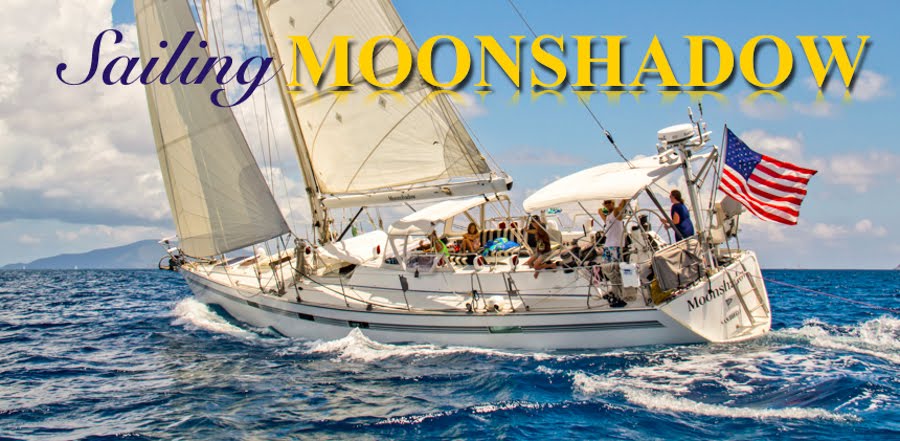The four weeks we spent in the Sea of Cortez were spectacular, but the time came to move on so we began our journey first south to La Paz for fuel and some provisions. Along the way, we revisited Agua Verde which absolutely glows at dusk.
Next was an overnight trip around the East Cape to Cabo San Lucas with it's iconic Land's End rocks marking the extreme southern end of the Baja Peninsula.
When you pass this point, it is almost impossible to not take a selfie with these rocks as a backdrop. Here' ours:
But inside the man-made harbor, it became obvious that things had changed since John's last landing here in 1971.
Besides the conspicuous tourist attractions, somebody let the word get out that the sport fishing here is fabulous. Walk these docks and you'll have no trouble finding a skipper willing to take you out for a day of fishing!
But our mission in Cabo was to clear out of Mexico for San Diego which meant a visit to the Port Captain and Immigration which are at opposite ends of town. The immigration office is upstairs where the clerks seemed to be about as concerned for our needs as their architect was for wheel chair bound disabled customers. Getting up this ramp in a wheel chair looks like it would be a bitch but the trip back to the ground floor has got to be quite a rush!
Our other mission in Cabo was to find a good weather window for the notoriously rough Baja Bash back up the coast. We lucked out and were on our way the next day, which gave us our last look at the arch called El Arco at Land's End.
We couldn't believe our luck. Cabo Falso, famous for big wind and steep seas, was a mill pond, about a rough as San Diego Bay. Further up the coast, we found we could roll out the big jib and motor sail at 9 knots. About the time we were sharing high fives for the great weather we noticed smoke in the engine room.
With Cabo San Lucas and diesel mechanics 85 miles behind us and 700 miles of desert coastline between us and San Diego, and after an hour in the engine room, we finally decided to return for repairs. 22 hours after leaving Cabo, we had our third view of Land's End in four days, this time with a beautiful sunrise.
Returning on a Sunday, besides getting more fuel there was nothing to do but rest until mechanics could start on Monday morning. A day and $500 of snooping later, the mechanics couldn't see a reason not to continue on to San Diego, so we left on Thursday morning before dawn. On this, our fourth pass around Land's End, we were treated to a setting full moon.
Missing this time were the calm conditions we'd had a few days before. Though not terrible, we could definately tell by the sounds Moonshadow made falling off of every wave why they call it the "Bash"!
Still, it's possible to find some beauty in the ocean's majesty even when motor-sailing to windward.
We arrived at Turtle Bay, roughly half way to San Diego, at sunset after 406 miles and 63 hours of smashing bad enough to shake the headliners loose. We slept like royalty in the peace and quiet of a flat anchorage.
Looking around the bay the next morning, we saw Eagle's Wings, the Westsail 32 that rafted next to Moonshadow through the locks in the Panama Canal. The last we'd seen Steve, who's single handing Eagle's Wings, was in Costa Rica. We spoke on the radio and learned he's leaving from Turtle Bay for Hawaii.
Our other business in Turtle Bay was getting fuel for the second leg up to San Diego. Rather than negotiate the rickety float tied to the even ricketier pier, Jesus arrived to offer us clean fuel in Panga jugs, which hold 50 liters each. We took twelve, and left that night at midnight.
The next hurtle was the notorious Isla Cedros passage. We chose to follow the advise of Capt. Jim Elfers, who authored the book "Baja Bash". Contrary to the prevailing belief that the East side of Isla Cedros with it's 20 miles of calm, protected water in the lee of the island is the only way to go north from Turtle Bay, Jim's advice is to pass the island to windward on the western side. We enjoyed a easy, smooth ride around Isla Cedros and settled in for a long boring motor up to San Diego. 337 miles and 46 hours later we finally tied to a slip at our beloved San Diego Yacht Club.
We are so happy to be in San Diego, our home for the next four months.
This is where grandkids can come for a swim-filled visit to Moonshadow.
You can actually get exhausted just watching kids this age have fun swimming for hours!
And your cheeks ache from smiling and knowing memories are being built.
"Gramma, is this enough clothes pins?"
Cool sailors always wear turk's head anklets!
With so much family here, we're enjoying things like "Grandparent's Day" at Steve (my brother) and his wife Wendy's ranch.
That includes the grandmas helping their granddaughters dress up.
Casey is a girl too!

A warm day is an opportunity for more swimming...
and girl talk...
...and snorkeling in the spa.
Meanwhile, the grand dads did guy stuff fixing ole 9130, a sabot with a lot of history, for the summer junior program this year.
So we're changing gears for a bit. We will take care of those items on Moonshadow's "To Do" list that cannot be easily done south of the border, visit friends and family, and take a mini cruise up to Catalina. Then it'll be time to get ready for the "Baja Ha-Ha" rally back to Cabo San Lucas in late October.
























































